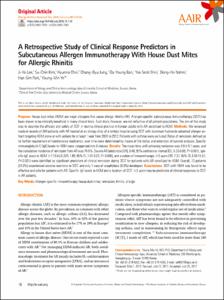KUMEL Repository
1. Journal Papers (연구논문)
1. School of Medicine (의과대학)
Dept. of Internal Medicine (내과학)
A Retrospective Study of Clinical Response Predictors in Subcutaneous Allergen Immunotherapy With House Dust Mites for Allergic Rhinitis
- Keimyung Author(s)
- Jung, Chang Gyu
- Department
- Dept. of Internal Medicine (내과학)
- Journal Title
- Allergy, Asthma & Immunology Research
- Issued Date
- 2018
- Volume
- 10
- Issue
- 1
- Abstract
- PURPOSE:
House dust mites (HDM) are major allergens that cause allergic rhinitis (AR). Allergen-specific subcutaneous immunotherapy (SCIT) has been shown to be clinically beneficial in many clinical trials. Such trials, however, are not reflective of all patient populations. The aim of this study was to describe the efficacy and safety of SCIT in routine clinical practice in Korean adults with AR sensitized to HDM.
METHODS:
We reviewed medical records of 304 patients with AR treated at an allergy clinic of a tertiary hospital using SCIT with aluminum hydroxide-adsorbed allergen extract targeting HDM alone or with pollens for at least 1 year from 2000 to 2012. Patients with asthma were excluded. Rates of remission, defined as no further requirement of maintenance medication, over time were determined by means of life tables and extension of survival analysis. Specific immunoglobulin E (IgE) levels to HDM were categorized into 6 classes.
RESULTS:
The mean time until achieving remission was 4.9±0.1 years, and the cumulative incidence of remission from AR was 76.6%. Severe AR (odds ratio [OR], 0.40; 95% confidence interval [CI], 0.23-0.69; P=0.001), specific IgE levels to HDM ≥17.5 kU/L (OR, 1.85; 95% CI, 1.01-3.37; P=0.045), and duration of immunotherapy ≥3 years (OR, 7.37; 95% CI, 3.50-15.51; P<0.001) were identified as significant predictors of clinical remission during SCIT for patients with AR sensitized to HDM. Overall, 73 patients (24.0%) experienced adverse reactions to SCIT, and only 1 case of anaphylaxis (0.3%) developed.
CONCLUSIONS:
SCIT with HDM was found to be effective and safe for patients with AR. Specific IgE levels to HDM and a duration of SCIT ≥3 years may be predictors of clinical responses to SCIT in AR patients.
- Keimyung Author(s)(Kor)
- 정창규
- Publisher
- School of Medicine (의과대학)
- Citation
- Ji-Ho Lee et al. (2018). A Retrospective Study of Clinical Response Predictors in Subcutaneous Allergen Immunotherapy With House Dust Mites for Allergic Rhinitis. Allergy, Asthma & Immunology Research, 10(1), 18–24. doi: 10.4168/aair.2018.10.1.18
- Type
- Article
- ISSN
- 2092-7355
- Appears in Collections:
- 1. School of Medicine (의과대학) > Dept. of Internal Medicine (내과학)
- 파일 목록
-
-
Download
 oak-2018-0063.pdf
기타 데이터 / 283.91 kB / Adobe PDF
oak-2018-0063.pdf
기타 데이터 / 283.91 kB / Adobe PDF
-
Items in Repository are protected by copyright, with all rights reserved, unless otherwise indicated.